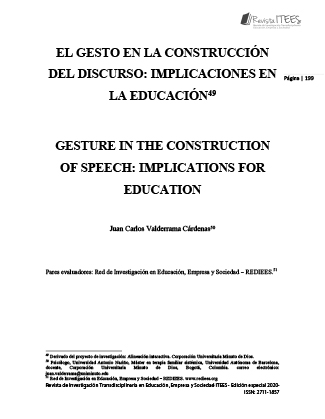IX. EL GESTO EN LA CONSTRUCCIÓN DEL DISCURSO: IMPLICACIONES EN LA EDUCACIÓN
##plugins.themes.bootstrap3.article.main##
Resumen
El presente estudio se basa en los recursos comunicacionales en la relación profesorestudiante, especialmente en la construcción del discurso hablado en la interacción, teniendo
en cuenta prácticas que pueden favorecer la comprensión mutua; se partió de la idea que las
manos reflejan el contenido del pensamiento. Se pretendió conocer las implicaciones de la
“manipulación” de los gestos de las manos en el discurso de 20 estudiantes universitarios.
A los participantes se les presento una escena de una caricatura y se les solicito recontar la
historia a otro participante que no conoce la escena, la situación cuenta con dos momentos:
a) relato libre y b) relato donde se estimula el uso de gestos. Todas las aplicaciones se
realizaron con cámara frontal y los vídeos fueron codificados con ELAN; el criterio de
marcación fue que el gesto fuera co-expresivo al habla y que la trayectoria fuera bien
definida. Se encontró que en la situación libre la narración es más corta y de menor
complejidad; en la situación de favorecer los gestos se usan mayor número de frases gestuales
y palabras. Como conclusión se argumenta que la comunicación en la educación se favorece
si se usan recursos verbales y no-verbales, lo cual tiene implicaciones para el profesor y el
estudiante en la ilustración-transmisión de ideas y conceptos.
Download Statistics
##plugins.themes.bootstrap3.article.details##
Gesto, comunicación, pensamiento, discurso, educación, aprendizaje, cognición.
Federmeier, The psychology of learning and motivation (pp. 107-133). Cambridge:
Elsevier.
Cook, S. W., & Tanenhaus, M. (2009). Embodied communication: Speakers’ gestures affect
listeners’ actions. Cognition, 113(1), 98-104. doi:
https://doi.org/10.1016/j.cognition.2009.06.006
Cravotta, A., Busà, M. G., & Prieto, P. (2018). Restraining and encouraging the use of hand
gestures: Effects on speech. 206-210. Paper presented at the Proceedings of the
International Conference on Speech Prosody. doi:10.21437/SpeechProsody.2018-42
Cravotta, A., Busà, M. G., & Prieto, P. (2019). Effects of encouraging the use of gestures on
speech. Journal of Speech, Language, and Hearing Research, 62(9), 3204-3219. doi:
https://doi.org/10.1044/2019_JSLHR-S-18-0493
Dargue, N., & Sweller, N. (2020). Two hands and a tale: When gestures benefit adult
narrative comprehension. Learning and Instruction, 68. doi:
https://doi.org/10.1016/j.learninstruc.2020.101331
ELAN. (2019). Nijmegen: Max Planck Institute for Psycholinguistics, The Language
Archive. https://archive.mpi.nl/tla/elan
Follari, J. E. (2015). El código de transcripción de Gail Jefferson: adaptación para las ciencias
sociales. Quaderns de Psicologia, 17(1), 39-62. doi:
https://doi.org/10.5565/rev/qpsicologia.1252
Kendon, A. (2017). Pragmatic functions of gestures: Some observations on the history of
their study and their nature. Gesture, 16(2), 157-175. doi:
https://doi.org/10.1075/gest.16.2.01ken
Lin, Y. L. (2017). Co-occurrence of speech and gestures: A multimodal corpus linguistic
approach to intercultural interaction. Journal of Pragmatics, 117, 155-167. doi:
https://doi.org/10.1016/j.pragma.2017.06.014
McNeill, D. (1992). Hand and mind: What gestures reveal about thought. Chicago:
University of Chicago press.
McNeill, D. (2005). Hand and Thought. Chicago: University of Chicago Press.
McNeill, D. (2016). Why We Gesture: The surprising role of hand movements in
communication. Chicago: Cambridge University Press.
McNeill, D., & Duncan, S. (2000). Growth points in thinking-for-speaking. In D. McNeill,
Language and gesture (pp. 141-161). Cambridge: Cambridge University Press.
Mondada, L. (2016). Challenges of multimodality: Language and the body in social
interaction. Journal of sociolinguistics, 20(3), 336-366. doi:
https://doi.org/10.1111/josl.1_12177
Parrill, F., McKim, A., & Grogan, K. (2019). Gesturing standard deviation: Gestures
undergraduate students use in describing their concepts of standard deviation. The
Journal of Mathematical Behavior, 53, 1-12. doi:
https://doi.org/10.1016/j.jmathb.2018.05.003
Valderrama Cárdenas, J. C. (2019). Por qué y para qué estudiar los gestos. In J. A. Bernate,
M. J. Betancourt Jiménez, J. A. Carrillo Villamizar, I. P. Fonseca Franco, M. F. García
Celis, W. S. Ortiz Navarrete, . . . Urrea Roa, Perspectiva de Transformación Social
en la Educación y la Empresa (pp. 73-103). Bucaramanga: Editorial Eidec.
Vigotsky, L. (1986). Pensamiento y lenguaje. Barcelona: Paidos





